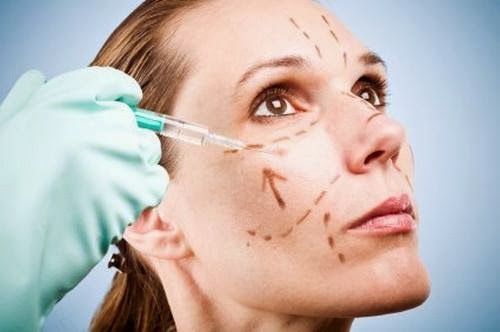 As we reach our mid 30's, the majority of us will develop lines on the upper half of the face commonly known as "worry lines", "frown lines" or "crow's feet". This undoubtedly makes one appear older and also can give a mean or tired look to the face. Some individuals also get tension headaches from constant usage of the forehead muscles.
As we reach our mid 30's, the majority of us will develop lines on the upper half of the face commonly known as "worry lines", "frown lines" or "crow's feet". This undoubtedly makes one appear older and also can give a mean or tired look to the face. Some individuals also get tension headaches from constant usage of the forehead muscles.
Everywhere you turn, it seems as though someone is getting BOTOX. In fact, it is by far the most popular minimally-invasive cosmetic procedure. BOTOX stops muscle movement and thus cause a relaxation and disappearance of the skin creases. In terms of "down time" and efficacy, it is superior to any form of surgical treatment for treating these lines. So if you're thinking about getting rid of some of those wrinkles, here's a short primer on BOTOX.
What is BOTOX?
"BOTOX" is short for Botulinum Toxin, which is produced by a bacterium called Clostridium Botulinum. It has been used since 1920, but was marketed commercially in 1997. It has a wide variety of clinical uses for people who have problems with spastic muscle disorders, or an imbalance in eye muscles, to name a few. It can also be used in hyperhidrosis or excessive sweating of the palms or axillary areas. It was as a result of using BOTOX for other problems on the face that its efficacy in getting rid of wrinkles was noted.
How does it work?
Don't be put off by the word toxin! BOTOX interferes with transmission of the nerve impulse to muscles and hence stops the muscle working for a period of time. To be used effectively, it must be placed at a correct dosage into the correct muscle. There are a number of facial muscles, and it is the contraction of these that is responsible for facial wrinkling. A plastic surgeon's knowledge of the anatomy of these muscles will allow for safe placement of the toxin.
Are the injections painful?
Most people tolerate the injections very well. They are delivered through very fine gauge needles. However, local anesthetic cream may be applied to the areas, one hour prior to treatment, for patients who are more sensitive. Ask your plastic surgeon about this.
How long does it take to work?
Results start to appear in three to five days, but may take up to a week. Finer wrinkles will disappear right away and more established ones take more time. With regular usage, one sometimes loses the habit of frowning altogether! If the wrinkles are very deep, ancillary treatment with filler materials about two weeks post injection may be necessary to achieve 100% result.
What are the side effects?
This is an important question and patients need be informed about the side effects. If for some reason the toxin moves to a muscle which is not a target muscle, such as the muscle which opens the eye or the ocular muscles which move the eye, then side effects can occur. These are rare and involve drooping of the eyelid, or double vision. Remember that the effects of BOTOX last only for four to six months at best, and when a really small dose causes a side effect, it usually reverses itself back to normal in three to four weeks.
How much does it cost?
The prices from clinic to clinic vary. The American Society of Plastic Surgeons 2011 Plastic Surgery Statistics Report shows that the national average surgeon/physician fee for BOTOX is $365 per area treated. Six to eight injections are typically required for the eyes, five for frown lines, and 10 to 12 for forehead lines.



